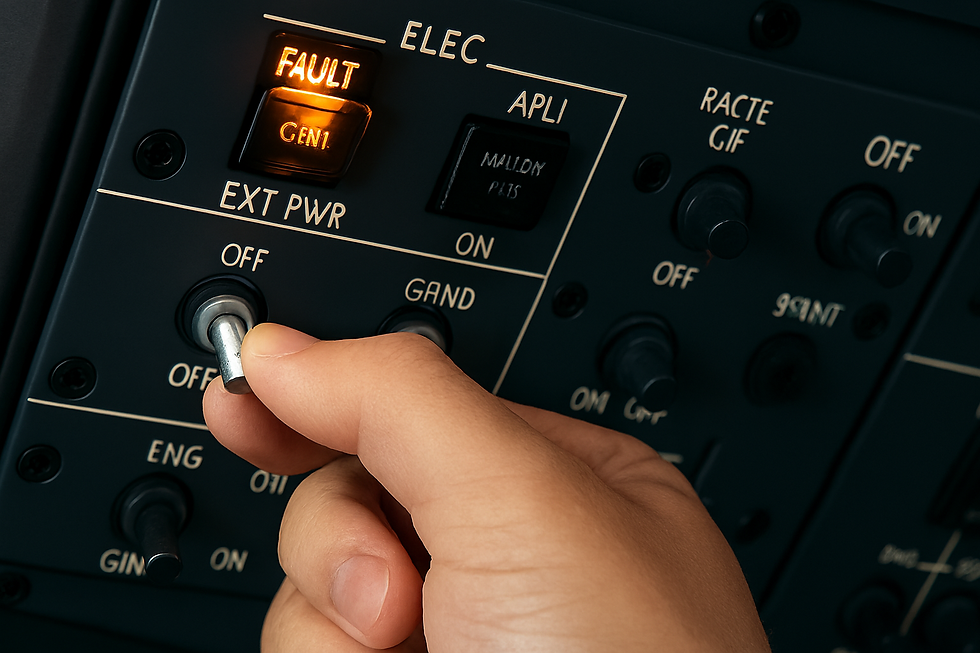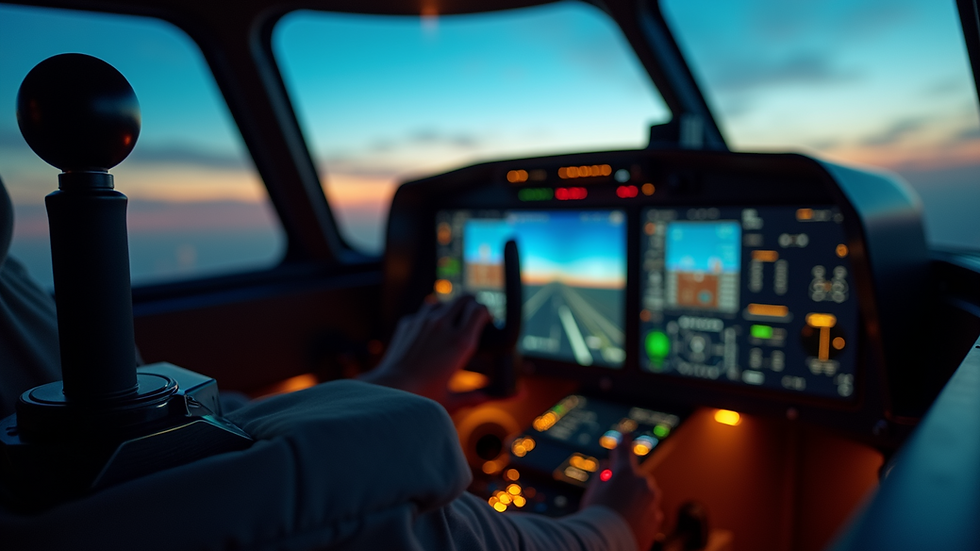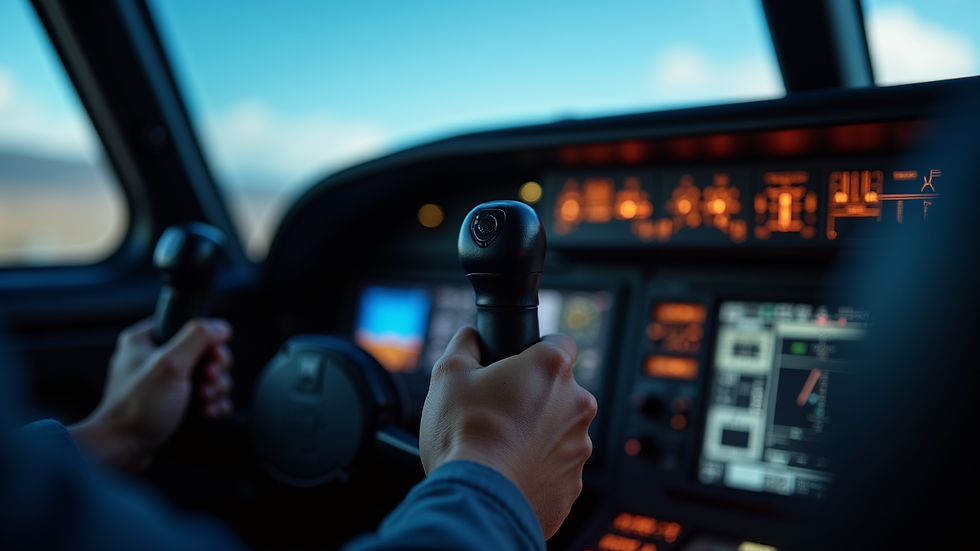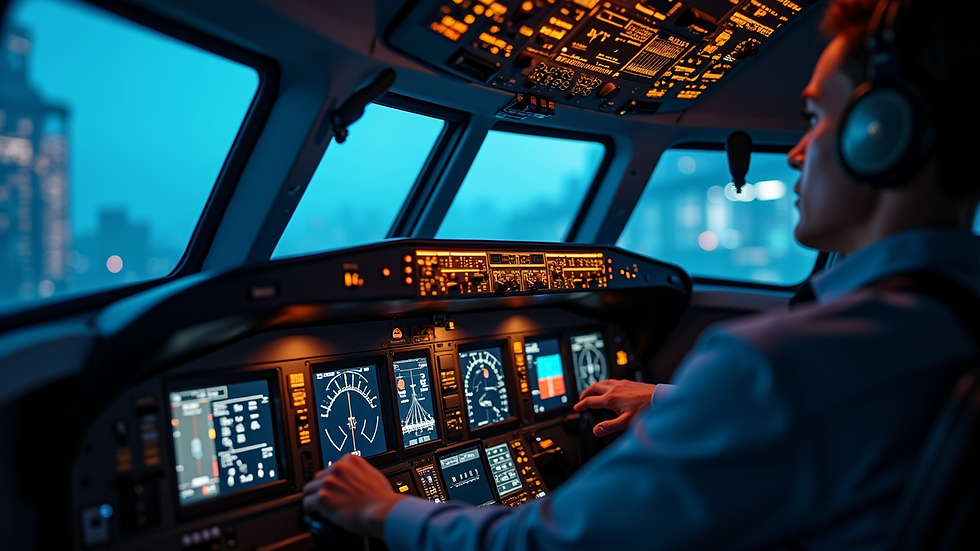Top Tips for Creating Your Own Flight Simulator
- Aug 5
- 5 min read
Welcome to the World of DIY Flight Simulation✈️
Building your own flight simulator is more than a hobby—it’s a thrilling fusion of aviation passion, technical creativity, and hands-on engineering. Whether you're a seasoned flight enthusiast, a student pilot preparing for the skies, or a tech-savvy tinkerer craving your next challenge, crafting a simulator at home offers an intensely immersive way to experience flight without ever leaving the ground.
This blog will equip you with essential insights and practical advice to help you design a simulator that fits your goals, space, and budget. From simple switch panels to complex cockpit builds, the journey is yours to define.

Feel the Click—Live the System🔧
There's a distinct magic in flipping a physical switch and watching your sim respond instantly—or seeing a warning light blink to life in real time, perfectly mimicking aircraft logic. These aren’t just technical achievements—they’re moments of connection. That tactile feedback creates a loop of satisfaction that transforms a pile of components into a living cockpit.
Whether you're wiring up a full overhead with functional annunciators or just experimenting with a few mapped switches, one thing’s sure: the thrill of “I built this—and it works” never gets old!
Planning Your Flight Simulator Setup
Key Considerations for Software & Aircraft Pairing
Aircraft-Specific Integration
Study-level platforms like ProSim, FlightDeck Solutions, and Project Magenta are game-changers. They model complex systems—hydraulics, electrical logic, FMS data—allowing virtually every switch, annunciator, and servo to mimic the real aircraft’s behaviour.
Compatibility with Interface Modules
Ensure your selected sim software supports IO boards like SimVim, Phidgets, Polabs, Arduino/Teensy setups, 737DIYSIM BOB (Break Out Board). MobiFlight’s free, community-driven updates and broad Arduino compatibility make it an unbeatable choice for builders seeking a powerful yet inexpensive custom setup. Without native compatibility or a solid SDK, even great hardware can feel lifeless.
Software Update Cadence & Community Support
Is the platform evolving with the real aircraft? Are bugs addressed quickly? A vibrant community often translates to faster troubleshooting, plugin development, and shared breakthroughs.
Licensing & Commercial Usage
Some sim software (like ProSim) has licensing tiers. If you're demonstrating at expos or using the sim in educational or commercial settings, ensure your usage aligns with these settings.

Essential Hardware Components for diy flight simulators
Choosing the right hardware is key to creating an immersive flight simulator. Here are the main components you will need:
Flight Controls: This includes a yoke or joystick, rudder pedals, and throttle quadrant. These controls mimic the real aircraft controls and enhance realism. For beginners, a joystick and throttle combo might suffice, but for more advanced setups, separate rudder pedals and throttle controls are recommended.
Computer: A powerful PC or laptop is essential for running flight simulation software smoothly. Look for a system with:
A fast processor (Intel i5 or better; ideally i7/i9 or AMD Ryzen 7/9 for advanced setups)
At least 16GB of RAM (32GB+ recommended for complex configurations)
A dedicated graphics card (NVIDIA RTX or AMD Radeon series)
Higher specs unlock deeper immersion: The better your CPU and GPU, the more cockpit systems, high-resolution scenery, and AI traffic can run simultaneously, translating to richer visuals and smoother performance.
Networked PC setups for advanced users: For experienced builders using professional-grade software like Prosim, sim loads can be distributed across multiple networked PCs. This offloads avionics, flight model processing, and instructor stations to secondary machines—freeing the main PC to focus solely on graphics and immersive rendering.
Displays: The visual experience is critical. You can use a single large monitor, multiple monitors for a panoramic view, or even VR headsets for full immersion. Multiple monitors provide a wider field of view, which is beneficial for situational awareness.
Audio System: Good quality speakers or headphones improve the experience by providing realistic engine sounds, ATC communications, and environmental noises.
Additional Accessories: Consider adding a flight instrument panel, GPS units, or even a custom-built cockpit frame for enhanced realism.
When selecting hardware, compatibility with your chosen software is essential. Many manufacturers provide plug-and-play devices specifically designed for flight simulators.

Setting Up Software and Calibration
Once you have your hardware, the next step is installing and configuring your flight simulation software. Follow these tips for a smooth setup:
Install the Software: Download and install your chosen flight simulator. Ensure your computer meets the minimum system requirements.
Update Drivers: Update your graphics card and peripheral drivers to the latest versions for optimal performance.
Configure Controls: Calibrate your joystick, throttle, and pedals within the software. Most flight simulators have built-in calibration tools. Take your time to ensure controls respond accurately.
Adjust Graphics Settings: Balance visual quality and performance by adjusting settings like resolution, texture quality, and anti-aliasing. Higher settings look better but require more powerful hardware.
Install Add-ons: Enhance your simulator with add-ons such as additional aircraft, scenery packs, or weather engines. These can significantly improve realism.
Practice and Experiment: Spend time flying different aircraft and experimenting with settings. This will help you understand your simulator’s capabilities and limitations.

Tips for Enhancing Realism and Immersion
To make your flight simulator experience as realistic as possible, consider these enhancements:
Use Realistic Flight Instruments: Physical instrument panels or USB instrument kits can replicate cockpit instruments, providing tactile feedback.
Add Motion Feedback: Some enthusiasts build motion platforms that simulate aircraft movements. While more complex and costly, this adds a new level of immersion.
Improve Visuals with Multiple Screens or VR: Expanding your field of view with multiple monitors or using a VR headset can make flying feel more natural.
Incorporate Realistic Weather and ATC: Use software add-ons that simulate real-world weather conditions and air traffic control communications.
Practice Procedures: Use checklists and follow real-world procedures to develop good habits and improve your flying skills.
Join Online Communities: Engage with other flight sim enthusiasts to share tips, participate in group flights, and learn from experienced pilots.
Resources and Communities for Flight Simulator Builders
Building a flight simulator can be complex, but many resources are available to help you along the way. Websites like 737DIYSIM offer detailed guides, parts lists, and community support for DIY projects.
YouTube channels and forums dedicated to flight simulation provide tutorials, reviews, and troubleshooting advice. Some popular forums include AVSIM and FlightSim.com.
Local flight clubs or aviation schools may also offer opportunities to try real simulators or get advice from pilots.
By tapping into these resources, you can avoid common pitfalls and accelerate your learning curve.
Taking Your Flight Simulator to the Next Level
Once your basic setup is complete, you might want to expand and refine your simulator. Consider building a custom cockpit frame using wood or metal to house your controls and displays. This can improve ergonomics and add to the immersive feel.
Experiment with different aircraft types and scenarios to broaden your skills. Try night flying, instrument approaches, or cross-country flights.
Keep your software and hardware updated to benefit from the latest features and improvements.
Remember, building a flight simulator is a journey. Enjoy the process, and don’t hesitate to upgrade or modify your setup as your skills and interests evolve.
Kind Regards, Karl


Comments